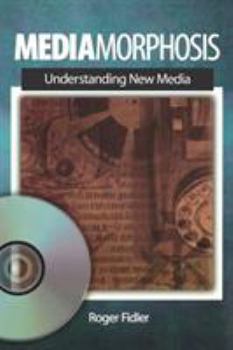Mediamorphosis: Understanding New Media
Select Format
Select Condition 
Book Overview
For use in undergraduate New Media Technology courses offered in Communication/Journalism. The text provides students with a theoretical and historical context to help place media technology developments in their proper perspective. The author does a fine job of projecting media and technology trends into the future while avoiding the "blue sky" approach of many works. Using non-technical language, he demystifies emerging technologies as much as...
Format:Paperback
Language:English
ISBN:0803990863
ISBN13:9780803990869
Release Date:February 1997
Publisher:Sage Publications, Inc
Length:320 Pages
Weight:1.00 lbs.
Dimensions:0.7" x 6.0" x 9.0"
Customer Reviews
4 ratings
A crystal ball for the future of newspapers
Published by Thriftbooks.com User , 25 years ago
This is clearly the most intensive and scholarly book on the future path for newspapers. Newspapers are not dead. But Fidler shows that cyberspace and technology will dramatically change the role of traditional newspapers during our next generation.
An insightful canvas of the evolving mediascape.
Published by Thriftbooks.com User , 26 years ago
"Mediamorphosis" by Roger Fidler is a breath-taking, sweeping overview of communications technologies and their impact on the media through the millenia and in the years to come. The treatment is academic and scholarly, with numerous case studies of the interaction between various media forms. Major principles guiding the evolution and evaluation of media technologies are illustrated.Ten chapters cover a wide range of issues including media evolution and convergence, media traits, digital technologies, Internet publishing, socio-political forces of control, new media experiments, virtual reality, user interactivity, and future trends. A list of acronyms and abbreviations is also included. Cited works feature "InfoCulture" by Steven Lubar, "The Story of Language" by Mario Pei, "Brainframes" by Derrick de Kerckhove, "The Control Revolution" by James Beniger, and "The Gutenberg Elegies" by Sven Birkerts.Roger Fidler (rfidler@saed.kent.edu) is a well-known electronic publishing visionary and practitioner. He has worked in the newspaper business for more than 34 years. He was the director of the Knight-Ridder Information Design Laboratory, founder of the PressLink online service for newspapers, and a key member of the Knight-Ridder Viewtron videotex service. Roger is currently a professional in residence at Kent State University. He is also quite active on the international conference circuit, and is a captivating speaker.Mediamorphosis, a term coined by Fidler in 1990, refers to the transformation of communication media, usually brought about by the complex interplay of perceived needs, competitive and political pressures, and social and technological innovations. Instead of studying each form separately, mediamorphosis "encourages us to examine all forms as members of an interdependent system, and to note the similarities and relationships that exist among past, present and emerging forms," Fidler begins.According to Paul Saffo of the California-based Institute for the Future, new ideas take about three decades to fully seep into a culture. There are three stages of diffusion, marked by phases of excitement, penetration and standardisation.The rate of adoption of a new technology in a society, according to media scholar Everett Rogers, is determined by factors like its perceived relative advantage, compatibility with existing technologies, overall complexity, reliability, and direct observability. Additional influences, according to British academic Brian Winston, come from accelerators and brakes such as socio-economic forces and political motivation. Fidler illustrates the interplay between these various factors in the manner in which FM radio at first floundered for about thirty years before dethroning AM radio in North America within a spurt of adoption of 10 years. Based on these perspectives and his own personal insights, Fidler identifies six principles of medi
Good basic information
Published by Thriftbooks.com User , 27 years ago
Fidler's book covers a lot of territory: he divides all of human history into three mediamorphoses, the first being speech, the second printed speech, and the third electronic speech. Along the way he covers such varied topics as the three types of communication (interpersonal, broadcast, and print), why interactive TV didn't work, implications for the future of print, and scenarios for how we will deal with information in our digital future. He's also written for a wide audience: he defines even basic terms like _personal computer_ and _mouse_ but also challenges the reader with detailed visions of new media and new lifestyles built around it. Some of the information is easily skimmed, some needs to be carefully examined and considered. Finally, he presents some interesting historical accounts of the effect of the Gutenberg printing press, early radio and television, and early interactive television. I recommend it for anyone who wants to know more about media's place in society and society's place in the media.
The best book on understanding new media
Published by Thriftbooks.com User , 27 years ago
Roger Fidler shows in a clear style what new media is all about: the interpersonal domain, the broadcast domain and the document domain. He also tries to learn from the mistakes of the past especially from the Videotex experiments in 1976-86. Read it!





